|
|
|
Sort Order |
|
|
|
Items / Page
|
|
|
|
|
|
|
| Srl | Item |
| 1 |
ID:
103973
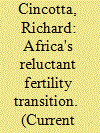

|
|
|
|
|
| Publication |
2011.
|
| Summary/Abstract |
Fertility decline and a maturing age structure typically prove more indicative of future human development . . . than do shifts toward economic or political liberalization. Why should it be any different south of the Sahara?"
|
|
|
|
|
|
|
|
|
|
|
|
|
|
|
|
| 2 |
ID:
191529


|
|
|
|
|
| Summary/Abstract |
Although originating in Algeria, AQIM and its allies had by 2012 become so entrenched in the Sahel that they were in de-facto control of vast swathes of territory in northern Mali. This article explains how and why GSPC/AQIM established itself in the Sahel, and why the group eventually decided to take the fight to the Sahelian countries, where they had previously found sanctuary. Relying on hitherto unused primary sources, this article is the first to show that the leadership of AQIM and al-Qaida Central did not want to engage in direct conflicts with the Sahelian states. The eventual shift of strategy in the region was brought about by the increasing numbers of Sahelians in AQIM's southern brigades.
|
|
|
|
|
|
|
|
|
|
|
|
|
|
|
|
| 3 |
ID:
139503
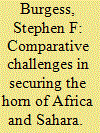

|
|
|
|
|
| Summary/Abstract |
Geography helps to explain why violent extremist organizations are difficult to counter; vast ungoverned spaces combined with weak states make it nearly impossible to decisively defeat them. However, partial success has been achieved by the United States in the Horn of Africa with a strategy of training, equipping, and supporting African intervention forces and attacking extremist leaders. In contrast, a strategy of containment in the Sahara, focusing on counterterrorism training for regional security forces and countering extremist ideology, did not succeed in preventing militant groups from taking over northern Mali and expanding their activities to other parts of the region.
|
|
|
|
|
|
|
|
|
|
|
|
|
|
|
|
| 4 |
ID:
124496
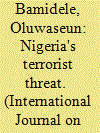

|
|
|
|
|
| Publication |
2013.
|
| Summary/Abstract |
The most immediate threat to the security of Nigeria is the Islamist insurgency raging in its north east region. Deadly attacks have killed a large number of people, devastated infrastructure, and hindered military success in this region and beyond. High ranking members of Al-Qaida may have been harbored, and the insurgents are affiliated with various militant sects, who pose a threat to wider sub Saharan Africa, especially Nigeria.
|
|
|
|
|
|
|
|
|
|
|
|
|
|
|
|
| 5 |
ID:
086851
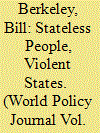

|
|
|
|
|
| Publication |
2009.
|
| Summary/Abstract |
Bogue, Mauritania- The border region between Mauritania and Senegal is a marshy green stretch of the Senegal River Valley on the southern edge of the Sahara, where the Arab world meets black Africa. The town of Bogue is a bustling trading outpost of low-slung, camel-colored office blocks flanked by tin-roof shops and crowded tenements.
|
|
|
|
|
|
|
|
|
|
|
|
|
|
|
|
| 6 |
ID:
105368
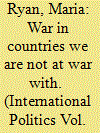

|
|
|
|
|
| Publication |
2011.
|
| Summary/Abstract |
This article examines the origins of the 'Global War on Terror' (GWoT) in peripheral locations; in other words, in countries and regions beyond Iraq and beyond Afghanistan. Although those two countries have remained the 'core' regions of the GWoT, the Bush administration also undertook many other military interventions in countries and regions in ostensibly peripheral locations under the auspices of the 'war on terror'; operations which it referred to in its 2006 Quadrennial Defense Review as 'war in countries we are not at war with'. These include operations in the Horn of Africa, Georgia and the Caspian region, the Philippines and the countries across the Sahara region including Mali, Niger, Chad and Mauritania. This article examines these peripheral theatres in the GWoT and argues that, by its second term, the Bush administration had moved beyond a state-based worldview vis-à-vis terrorism and had truly come to understand it as a transnational problem; a protean network that should be tackled through using Special Operations Forces and unconventional warfare to wage 'war in countries we are not at war with'. The article also considers the extent to which these operations on the 'periphery' were expedient in other ways that often transcended the war on terror because they coincided with the existence of long-standing or newly identified US strategic interests. Finally, the article considers the Obama administration's continuation - and in some cases escalation - of many of the Bush administration's operations in peripheral regions, even as Obama looks to wind down the war in Iraq.
|
|
|
|
|
|
|
|
|
|
|
|
|
|
|
|
| 7 |
ID:
101146


|
|
|
|
|
| Publication |
2010.
|
| Summary/Abstract |
Conservation non-governmental organisations (NGOs) have excited a great deal of comment and debate, generally quite divided, in diverse journals. Some advocate them as forces for good, others decry their clumsy dealings with rural peoples and the impoverishment their activities can cause. The debate suffers in two ways. First, it ignores a large parallel literature about the work of development NGOs. Second, there is a paucity of general knowledge about the state of the conservation NGO sector. We do not know where it works, what the main players are doing, or much at all about the extent or activities of the smaller conservation organisations. We do not know how much money the sector spends. In this paper we first briefly outline why work on development NGOs should be applied to conservation NGOs, and then offer an overview of the sector's activities based on a survey of over 280 organisations. We describe some of the basic contours of these activities, and reflect on the implications of our findings for existing writings about conservation NGOs and future research.
|
|
|
|
|
|
|
|
|
|
|
|
|
|
|
|
|
|
|
|
|